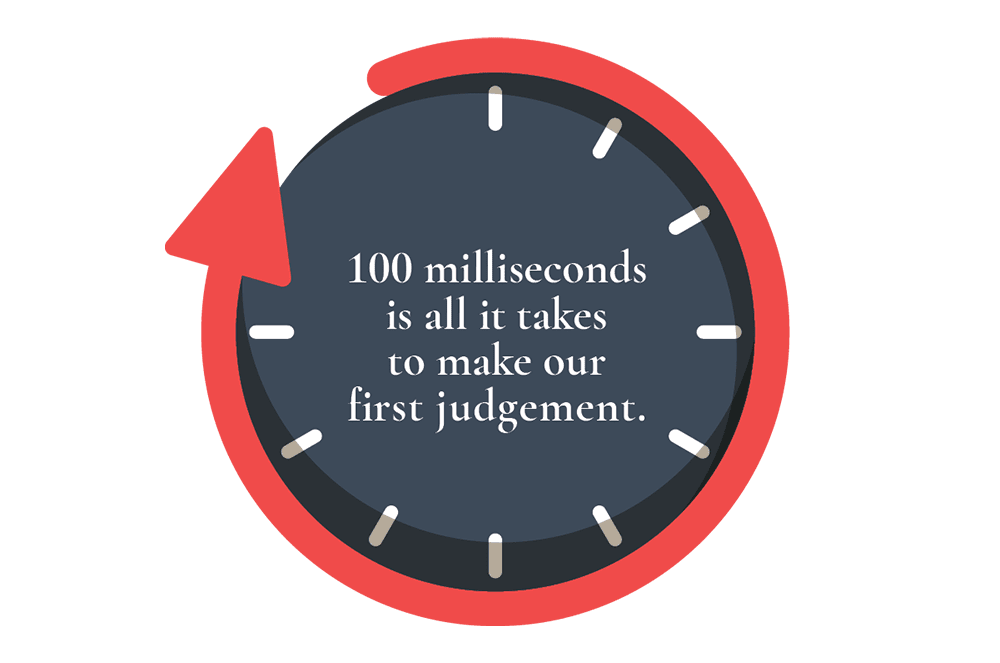
Despite the popular advice, we actually do judge a book by its cover. We can’t help it.
Our brains start firing the moment somebody walks into the room or hops on the call. And by the time that first meeting is over, we’ve built most of our mental model of that person. Do we like them? Do we believe them? Do we trust them? While our first impression doesn’t fully answer those questions, it can set us on a path toward that answer.
In a perfect world, we’re all judged after careful consideration, weighing the relative merits of our words and deeds. But we don’t live in that world and we never have. We’re wired to pick up on cues from our environment that help us make decisions. Making quick determinations about that rustling branch or saber-toothed face helped our ancestors avoid becoming lunch. And if we want to avoid a modern version of that fate, it’s in our interest to understand and make the most of the science of first impressions.
Mind Your Face
Looking at somebody’s face is quite literally the first in first
impressions—and we begin to construct our opinions almost instantaneously. showed that we make most of our judgment on a person’s trustworthiness, competence, likability, aggressiveness, and attractiveness within just 100 milliseconds of exposure to a person’s face. Without exaggeration, this impression is drawn in less than a blink of an eye.
Everything you do contributes to that first impression.
While it’s rude to tell a stranger to smile, if you want to make the most of those scarce milliseconds, well, you should probably smile. A wide body of research suggests that genuine smiles make you seem more sociable, more polite, more pleasant, and more honest than people who don’t smile. But beyond those somewhat obvious conclusions, it’s important to understand that different types of smiles can convey different meanings.
In a , researchers identified a relationship between the intensity of your smile and how warm or competent you come across. A big, broad smile is seen as warmer but can be read as less competent. Inversely, a person with a slight, more modest smile frequently scored as more competent, but less warm.
Depending on your situation, one of these values can trump the other. For example, in one of their experiments, teams on Kickstarter, a platform for creative businesses to fundraise, boasting broad smiles got more Facebook shares and small-dollar donations, but the team with slight smiles in their photos were more likely to bring in larger individual checks.
Speak With Your Body First
In addition to the face, the body also conveys all sorts of information in a first impression. Generally, we understand open postures, such as uncrossed arms and legs, as associated with approachability and openness. On the other hand, crossing our arms or otherwise defensively framing our bodies (think boxer or bodyguard) makes us read as unfriendly, unwelcoming, and closed to new ideas.
That said, other body language cues leave positive impressions as well. Research indicates that using hand gestures when speaking can make us more engaging, that sitting or standing tall can convey more confidence, and that nodding along can build rapport. Even subtle mirroring of our counterpart’s gestures and posture can help us build a deeper connection.

And ultimately, the advice your dad gave you all those years ago was also right: give a firm handshake. tested this bit of folk wisdom by shaking over 100 hands with various degrees of intensity. The better your grip, the higher you rate for extraversion and openness. Give the proverbial “dead fish” handshake, and you’ll come across as more shy and neurotic.
Get the Whole Package Right
Everything you do contributes to that first impression. Confronted by new stimuli, our brains are firing away, sucking up as many clues and cues as it can find to figure out what to make of you, and whether we should believe and trust what you’re saying.
Our clothing matters. Eccentric or non-traditional clothing can make us read as more creative and free-thinking, but stained and wrinkled clothing gives off the impression that we’re irresponsible and undisciplined. Darker fabrics give us more authority, and uniforms make us more trustworthy. Across a wide range of research, we see over and over that this packaging shapes how we perceive the product (in this case, ourselves).

What if we meet somebody virtually? On a Zoom or Google Meet call, better lighting makes our face more visible and our impression warmer. A clean background makes us come across as more professional. And in , researchers found that, even when the content was identical, better audio quality makes a speaker come across as more intelligent and professional—so invest in a good microphone.
If we’re giving a presentation, even the typeface of our slides can make a difference. Experiments show that bold text is perceived as more authoritative and memorable, more rounded letters are warm and approachable, and fonts with sharp angles can be read as urgent or even aggressive.
Adding It All Up
Taking it all together, there’s not a single magic pill here. Over millions of years, we’ve evolved to quickly pick up on signals from our environment to help us make decisions—who is a friend and who is a foe, who can we trust and who should we be wary of.
But if you have to boil it down, it all comes back to intention and effort. The cues of smiles and body language are just visible signals of our positive intentions. The firm handshakes and sharp outfits are manifestations of our efforts.
The most critical factor in making a good first impression is to want to make a good first impression. Everything else comes from that.
Share this article
Ben Guttmann is a marketing executive, adjunct faculty at Baruch College in New York City, and the author of Simply Put: Why Clear Messages Win—and How to Design Them. Learn more at .
Related Articles

Presentation Skills
The Power of First Impressions

Professional Development
An Introduction to Masterful Introductions

Communication



 Previous
Previous

 Previous Article
Previous Article